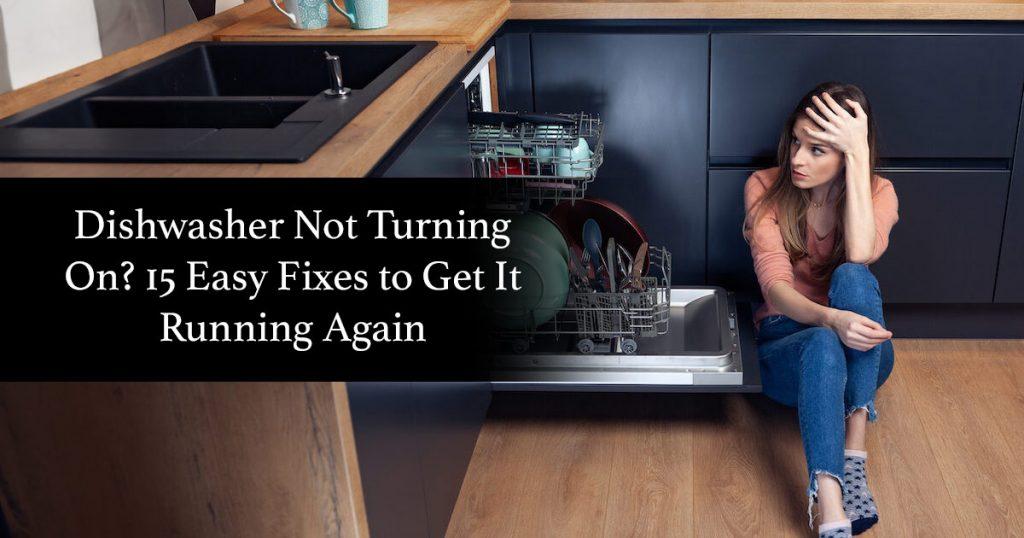68% of American homes have a dishwasherAbout 68% of American homes have a dishwasher in the kitchen. Of those, around 50% use their dishwashers 1 to 6 times a week, and larger households tend to use them even more often. As dishwashers become an essential part of your life, it can be frustrating and inconvenient if your dishwasher is not turning on. Thankfully, you can easily fix many common issues. Fortunately, simple troubleshooting can fix many problems.
Here are 15 simple tips to help you figure out why your dishwasher won’t start and how to fix it.
1. Check the Power Supply
If your dishwasher is not turning on, the first thing to check is whether it’s getting power.
- Inspect the Power Cord: Make sure the dishwasher is securely plugged in. At times, the plug may become loose or disconnected. If the breaker hasn’t tripped and the dishwasher won’t turn on but has power, you might need to look deeper into the issue.
- Check the Circuit Breaker: Check your home’s circuit breaker panel to discover if the dishwasher breaker has tripped. If it has, reset it by turning it off and then back on. If the control panel or the dishwasher won’t turn on and no lights appear on the display, the control board might need to be replaced.
2. Examine the Light Switch
In some homes, a light switch near the sink controls the dishwasher’s power. Make sure this switch is turned on. It’s an easy step, but many people miss this simple fix.
3. Check the Door Latch
If the door latch isn’t working, your dishwasher won’t start.
- Look for Blockages: Food or debris can block the door latch, stopping it from closing correctly.
- Test the Latch: Test the door’s tightness by opening and closing it. Replace the latch if it’s loose or doesn’t lock.
4. Reset the Dishwasher
A reset may help when your dishwasher is not starting.
- Unplug and Replug: Unplug the dishwasher for roughly a minute before plugging it back in.
- Press the Reset Button: Some dishwashers include a reset button. Hold it for a few seconds to restart the machine.
5. Check the Child Lock Feature
Some dishwashers have a child lock that stops the machine from starting. Check your handbook to see how to disable the child lock if it is enabled.
6. Test the Start Button
If the dishwasher start button is not working, it might be broken.
- Inspect for Damage: Look closely at the button for any visible wear or damage.
- Try Pressing Multiple Times: Sometimes pressing the button several times can help if it’s stuck or unresponsive.
7. Inspect the Timer Controls
The timer controls when your dishwasher starts its cycles.
- Listen for Noises: The timer may be broken if you hear buzzing or clicking.
- Use a Multimeter: Test the timer with a multimeter to check if it’s working. Replace it if needed.
8. Check the Thermal Fuse
The thermal fuse cuts off power to stop the dishwasher from overheating. To locate and test the fuse, unplug the dishwasher and find the thermal fuse (usually inside the door panel). Utilize a multimeter to test for continuity. If a fuse blows, replace it.
9. Examine Selector Switches
Selector switches control the dishwasher’s cycle options.
- Make Sure Only One Button is Pressed: If two buttons are pressed at the same time, the dishwasher might not start.
- Test the Switches: Check if each button works correctly. If not, replace the faulty switch.
10. Inspect the Motor Start Relay
The motor start relay powers the motor when you start a cycle. Find the relay behind the lower panel and use a multimeter to test it. If it’s faulty, replace it.
11. Check for Drainage Problems
If water isn’t draining properly, your dishwasher may not start.
- Inspect the Drain Filter: Make sure there’s no food or debris blocking the filter.
- Check the Drain Hose: Check for a blockage or kinks in the hose that could prevent water from draining.
12. Look for Faulty Wiring
Damaged wiring can stop your dishwasher from getting power.
- Inspect Wiring Connections: Check inside the dishwasher for frayed cables or loose connections.
- Call a Professional: If you find damaged wiring, it’s safer to call an electrician or repair technician.
13. Check the Control Board
A damaged control board can cause your dishwasher to malfunction.
- Look for Damage: Inspect the control board for evidence of burning or corrosion.
- Replace if Necessary: If the control board is damaged, you may need to replace it.
14. Consult the User Manual
Your dishwasher’s manual can help you troubleshoot specific issues for your model.
- Follow the Instructions: Refer to the manual’s troubleshooting section for help.
- Online Resources: Many manufacturers have online manuals and support pages that can provide further assistance.
15. Call a Professional
If you’ve tried all the steps and your dishwasher still won’t start, it’s time to call a professional.
- For Complex Issues: Problems like motor failure or electrical issues are best handled by an expert.
- Avoid Further Damage: Attempting to address complex issues on your own can cause more damage or even pose a safety concern.
When your dishwasher is not turning on, you can troubleshoot and potentially fix the problem by following these 15 tips. You can resolve many issues without professional help, whether it’s a simple power issue or a faulty part. However, always remember to disconnect the power before attempting any repairs and seek professional assistance for complex problems.
